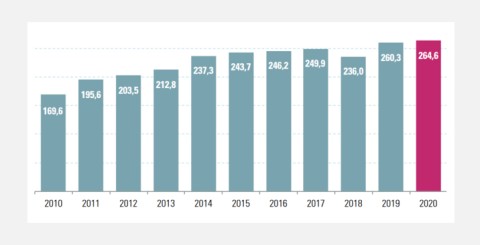Because mental health matters
Corporate health management is multifaceted – Infraserv Höchst provides special risk assessment
Successful companies invest in their employees. Not just in training, better work conditions and programs to strengthen employee motivation and organizational identification – but in employees’ health, too. Indeed, health has become a major workforce factor. This is partly due to demographic changes and the fact that people are staying in the labor force longer, and partly due to the skilled labor shortage and the growing need for companies to retain older employees. All these factors have made health a core business issue.
Moreover, skilled workers pick employers based on multiple criteria, which now include corporate health promotion programs. Many prospective employees want more than just bonuses or a company car; they are also looking for exercise classes and preventive check-ups. Integrated corporate health management has become a key success factor for forward-looking organizations.
Wide-ranging health programs
The 20,000 employees working at the roughly 90 firms based at Industriepark Höchst value and appreciate the wide range of services provided by Infraserv Höchst’s Industrial Clinic. The site operator offers a broad portfolio ranging from pre-employment medical exams to regular health checks for certain occupational groups to campaigns such as flu shots or skin cancer screening. Employees at Industriepark Höchst can drop in at two site health centers where they can work out on various pieces of equipment, just like in a commercial gym. Classes run the gamut from tai chi to core training and even include topics such as nutrition counseling. One aspect has gained prominence in recent years, especially during the COVID-19 pandemic: employees’ behavioral health. For some employees, what really hurts is mental, not just physical.
Percentage of mental illnesses rising
“The percentage of total sick leave attributed to mental illness has risen steadily in the past 20 years,” noted Dr. Martin Kern. He manages Infraserv Höchst’s Health and Safety unit, which includes the Industrial Clinic. Psychological disorders may not be the leading causes of disease, but they certainly keep employees on sick leave for much longer: Employees who are unable to work for psychological reasons stay home an average of twice as long as people with injuries or cardiovascular complaints.
Peak in absences due to mental illnesses.
Working days lost per 100 insureds. Source: DAK Psych Report 2021.
“Our main goal is to help people and attempt to reduce psychological stress and identify mental illness as early as possible,” said Dr. Kern. However, professional health management delivers tangible economic benefits for employers, too, especially when it comes to mental illness. Every day away from work costs productivity and money; mental illnesses that require long absences thus have an enormous impact on companies.
The percentage of total sick leave attributed to mental illness has risen steadily in the past 20 years
Dr. Martin Kern, Head of Occupational Health and Safety at Infraserv Höchst
Risk assessment for mental stress
Infraserv Höchst has been conducting risk assessments that specifically include mental stress in its own organization – there are around 2,700 employees in the Infraserv Höchst Group – and for various customers for years. “Workplace risk assessments are part and parcel of day-to-day business in the chemical industry,” explained Dr. Kern. “However, we specifically assess psychological stress and collaborate with the company and its managers to identify concrete action to take in response.” The risk assessment consists of planning, analysis, workshopping and monitoring. First, all key stakeholders are brought on board and involved in the planning, then an analysis is performed in the form of anonymized surveys before the data is evaluated. The next key step is a workshop in which employees, managers and experts discuss the findings and identify responses that are subsequently monitored for effectiveness. “We’ve had good experience with this approach within our own company and at our customers’ organizations and continue to develop and refine it every day,” reported Dr. Kern.
One important effect is better employee and manager awareness. “We also talk about methods for identifying mental changes among employees and coworkers, the best ways to respond and what professional assistance is available,” explained Dr. Kern.
e-Health: business success factor in occupational medicine
Efficiency enhancement and quality improvement
Many things can be and are digitalized in occupational medicine. However, digitalization will not start delivering real economic benefits until all the stakeholders recognize and seize strategic opportunities that can help enhance efficiency in areas such as clinic management. Digital communication tools can also improve quality. For example, professional codes of conduct now permit telehealth virtual visits, eliminating the requirement for doctors and patients to always meet in person. While virtual visits obviously cannot replace personal appointments in all situations and fields of medicine, the ability to provide occupational medical services remotely represents a tremendous business opportunity. e-Health also makes it possible to broaden the occupational medicine portfolio. One example: using sensors worn by employees to capture health data while doing work. Sending an employee’s heart rate, blood glucose or body temperature directly to the occupational physician can help quantify workplace stress. In short, the combination of classic occupational medical services and supplementary e-health innovations offers tremendous opportunities to develop an attractive product portfolio for customers who have made corporate health management a high priority.






